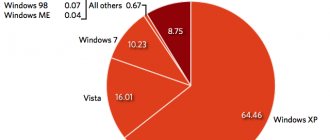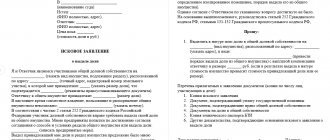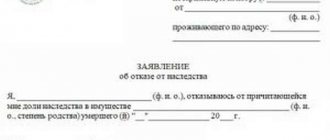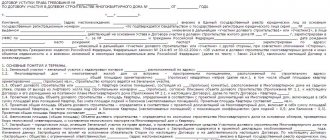Notes
- ↑ 12
Share in the Great Soviet Encyclopedia. Retrieved May 27, 2011. Archived August 22, 2011. - ↑Money of Russia. Retrieved July 7, 2011. Archived August 22, 2011.
[td] This is a preliminary article about units of measurement. You can help the project by adding to it.
What is wiki2.info Wiki is the main information resource on the Internet. It is open to any user. Wiki is a library that is public and multilingual.
The basis of this page is on Wikipedia. The text is licensed under CC BY-SA 3.0 Unported License.
Wikipedia® is a registered trademark of the Wikimedia Foundation, Inc. wiki2.info is an independent company and is not affiliated with the Wikimedia Foundation.
Source
Online converter of shares, conversion of dozens, percents, ppm and other units
In everyday life, we constantly use different numbers, both integers and fractions. These can be units of volume, length, weight, price and much more. Quite often, instead of a specific number, we use everyday conventional units, for example, a pair, a quarter, a dozen, a ten, a third, a damn dozen. How many real units are contained in conventional ones, for example, in a dozen, our Online Share Converter will help you quickly calculate.
How to use the share converter
Using the converter is easy. To do this, you need to place the number of units in the number field, then select the name of the share that you have and the name of the share that you want to receive. For example, we have 10 pairs, we need to find out how many tens it will be. We put the number “10”, select the cash share - “pair” and the one you need to get - “ten”. Click “Translate” - the result is “2”.
The converter can easily handle the translation of large numbers, even such as quadrillion (10 15), quintillion (10 18), sextillion (10²¹).
Here you can convert percentages into numbers and vice versa, as well as calculate ppm
What is a fraction in mathematics?
As mentioned above, a share is understood as a part taken from any whole object. Regarding the proportion of numbers that mathematics operates on, we can say that this is each of the equal parts of the number. Let's give an example, take two numbers - 2 and 12 and find out how they relate to each other in terms of part and whole. The answer will be as follows. 2 is one sixth (1/6), that is, one of six parts of 12. This number can be represented as the sum of six equal parts, each of which is equal to 2: 12 = 2 + 2 + 2 + 2+ 2.
Now let's answer the question: how to find a fraction of a number? And it's very easy to do. Let's use the numbers from the previous example. To find the fraction of the number 2 in the number 12, you need to divide the second by the first. 12:2 = 6.
Shares of the whole
Dividing a whole into shares is familiar to everyone from early childhood, this is half of a candy that you shared with a friend, a slice of tangerine and a birthday cake. In life, we encounter such problems at every step, and they are so familiar that no one focuses on them. The fraction converter will help you calculate what numerical equivalent they correspond to for different units.
In mathematics, fractions are used to represent parts of a whole.
- For example, if you divide a whole into two equal parts, you will get two identical halves, denoted by the fraction ½.
- If divided into three parts, then each of them is called a “third” and is written as ⅓.
- When we divide a whole by four, then each of the parts will be a quarter and we will write it as 1/4. etc.
In everyday life, different fractions and numbers have their own special name. For example, we are used to calling two identical things a pair, so the number “2” is often called that. same. Ten is ten, twelve is a dozen, six is half a dozen.
Let's look in the dictionary
When figuring out the meaning of the word “share,” first of all, let’s check the dictionary. There we will see many interpretations of the linguistic object that interests us. These include:
- Part of an object that is expressed quantitatively or qualitatively. Example: The Azovsky Fish Processing Plant significantly exceeds all its related companies in terms of production volume; its share in the regional market exceeds 30%.
- In the old days in Rus' this was the name of a unit that was used to measure mass. Example: A unit of measurement such as a share was the smallest, it is associated with the weight of one grain of wheat.
- Designation of someone's participation in the capital of a particular company. Example: The state’s share in was quite large, which gave this company the opportunity to count on serious preferences when paying taxes.
However, the meanings of the word being studied do not end there.
A dozen simple and damn
The number 12, or, as we used to call it, a dozen, deserves special attention in the number system. Why such special attention to this number and what is its secret?
The word itself came to us from Europe; in many countries its pronunciation is very similar, for example in Italy “dozzina”, in France “douzaine”. But its origin has Latin roots “Duo-decim” meaning “two and ten”.
Sumerian counting system and the number 12
The number 12 owes its special status in the modern decimal number system to the deep past. Previously, the Sumerian duodecimal system was adopted as the basis for calculations. Her “legacy” remains in our time:
- the earthly year is divided into 12 parts (months);
- The celestial sphere was divided into 12 zodiac signs in ancient times;
- the day consists of two cycles (presumably day/night) of 12 hours;
- an hour consists of 60 minutes - these are 5 parts of 12;
- There are 60 seconds in a minute, also 12*5=60;
- cutlery is designed for 12 or 6 people.
At first glance, the metric decimal system is much more convenient and practical, because even on two hands we have 10 fingers. But in the Sumerian system, human hands were also taken as a basis. If you look at the hand from the palm side, you can clearly see that on four fingers we have exactly 12 phalanges, three on each. The Sumerians used their thumb to count them.
Excerpt describing Share (unit of measurement)
- And why could you believe that he is my lover?... Why? Because I love his company? If you were smarter and nicer, I would prefer yours. “Don’t talk to me... I beg you,” Pierre whispered hoarsely. - Why shouldn’t I tell you! “I can speak and will boldly say that it is a rare wife who, with a husband like you, would not take lovers (des amants), but I did not,” she said. Pierre wanted to say something, looked at her with strange eyes, the expression of which she did not understand, and lay down again. He was physically suffering at that moment: his chest was tight, and he could not breathe. He knew that he needed to do something to stop this suffering, but what he wanted to do was too scary. “It’s better for us to part,” he said falteringly. “Part up, if you please, only if you give me a fortune,” said Helen... Separate, that’s what scared me! Pierre jumped up from the sofa and staggered towards her. - I'll kill you! - he shouted, and grabbing a marble board from the table, with a force still unknown to him, he took a step towards it and swung at it.
Percentage and ppm
One percent is a hundredth of the whole. If we take one as a whole, then the percentage can be expressed through a fraction - 1/100. It got its name from the Latin “pro cento”, which translates as “for a hundred”. Indicated by the % symbol.
Permille is one thousandth of the whole. The name comes from the Latin “pro mille”, which translated means “for a thousand”. Indicated by the ‰ icon. Permille is a close relative of percentage; they are similar, but still different and difficult to confuse. Permille is used wherever it is necessary to calculate a small fraction of the whole.
There is an opinion that ppm is used only to determine the level of alcohol in the driver's blood. This is not true. With the same success it can be argued that liters are intended only for the amount of gasoline poured at a gas station.
The fraction converter will help you quickly calculate percentages and ppm of a number or vice versa. If you need more complex calculations, use a percentage calculator.
Online area converter, area units in different systems, their quick translation
Online converter of number systems, translation between decimal, binary, octal and other systems
Online density converter, calculation formulas and units of measurement
Temperature converter, conversion of degrees Celsius, Fahrenheit, Kelvin, Reaumur
Kilowatt to horsepower conversion calculator
Source
Fractions of a unit
A unit can be divided into equal parts.
Example. Let us represent the unit as a segment and divide it into three equal parts:
Each of these equal parts into which a unit is divided is called a fraction of the unit, a fraction of the whole, or simply a fraction.
The fraction of a unit is each of the equal parts into which the unit is divided.
When a unit is divided into equal parts, the shares are given a name that depends on how many parts the unit was divided into.
Example. If a unit is divided into 5 equal parts, then each part is called a fifth (part), and all together are called fifths (parts):
The name of the share indicates what part of the unit it is, and also makes it clear how many equal parts the unit was divided into.
In Ozhegov's dictionary
SHARE, -i, pl. -and, -ey, w. 1. Part of something. Divide into equal shares. Lion's village (the largest and best part of something). Enter into the share (share). 2. Fate, fate. Happy d. There is no share for anyone. (there is no happiness in life; outdated). * Whose share (fall, fall, get) - become someone’s. fate, to fall (in 3 digits) to someone, to someone. fate. He faced many trials. || decrease slice, -i, g. (to 1 value). || caress. share, -i, f. (to 2 digits). || adj. long, -aya, -oe (to 1 meaning; special).
Common fractions
Common fractions are used to describe the number of shares.
A common fraction is a number that expresses the number of parts. A common fraction is otherwise called a simple fraction or just a fraction .
A fraction is expressed orally and in writing as two numbers. The first number indicates the number of beats (for example, three), the second - which beats (for example, fifths).
An ordinary fraction is written like this: write a number showing the number of shares:
A horizontal line is drawn under this number and a second number is written under the line, showing what the shares are:
where m
— zero or natural number,
n
— natural number.
Thus, the mathematical notation of a common fraction consists of two numbers that are separated from each other by a horizontal line.
Example. Let us represent the unit as a segment, which is divided into 9 parts. Let's mark one, two and four beats on it:
Let us express the selected quantities of shares as fractions. One share is expressed as a fraction
, two parts are expressed as a fraction, four parts - . Each fraction is one ninth of a unit:
Some ordinary fractions have their own names, which are often used in everyday life. So, one second share is also called a half , one third share is a third , one fourth share is a quarter :
Source
Task 5
In Figure 12, the circle is divided into six equal parts.
Rice. 12. Circle divided into 6 parts
In the first circle, one share is taken, so we write down, read “one sixth.” In the second circle, four beats are taken, we write down, read “four sixths.”
Let us remember the rule: if the numbers below the line are the same, then we compare the numbers above the line. Four is more than one, we put the sign:, it reads like this: “one sixth is less than four sixths.”
Unit share
Related concepts
Mentions in literature
Related concepts (continued)
With a constructive approach to determining a real number, real numbers are constructed based on rational ones, which are considered given. In all three methods described below, rational numbers are taken as a basis and new objects called irrational numbers are constructed. As a result of adding them to the set of rational numbers, we get a set of real numbers.
Central limit theorems (C.L.T.) are a class of theorems in probability theory that state that the sum of a sufficiently large number of weakly dependent random variables that have approximately the same scales (none of the terms dominates or makes a determining contribution to the sum), has a distribution close to normal.
Not to be confused with the “simplex method” - a method for optimizing an arbitrary function. See Nelder-Mead method. The simplex method is an algorithm for solving an optimization problem of linear programming by enumerating the vertices of a convex polyhedron in a multidimensional space.
The renormalization group method (also often called the renormalization group method, RG method) in quantum field theory is an iterative renormalization method in which the transition from regions with lower energy to regions with higher energy is caused by a change in the scale of consideration of the system.
The values of commercially produced electronic components (resistor values, capacitor values, inductance of small inductors) are not arbitrary. There are special series of denominations established by the standard, which are sets of values from 1 to 10. The denomination of a part of a certain series is some value from the corresponding series, multiplied by an arbitrary decimal factor (10 to the integer power).










